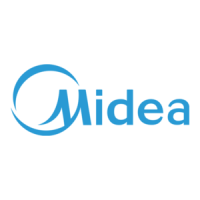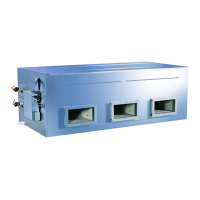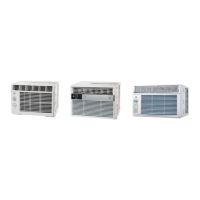
Do you have a question about the Midea H2 Series and is the answer not in the manual?
| Refrigerant | R410A |
|---|---|
| Power Supply | 220-240V, 50Hz |
| Voltage | 220-240V |
| Type | Split System |
| Features | Auto Restart, Sleep Mode |
| Operating Modes | Cool, Heat, Fan, Dry, Auto |
| Fan Speeds | Low, Medium, High, Auto |
Shows examples of ceiling, floor, and concealed installations.
Unit meets latest CE certification requirements.
Describes the standard cased and optional uncased unit appearances.
Details the range of models, airflow, static pressure, and power supply.
Explains the meaning of each part of the model code (Midea, type, rows, etc.).
Electrical specs and air flow rates (H/M/L) for various models.
Capacity, water flow, and pressure drop for cooling and heating.
Dimensions and weight for H2 (cased) and H3 (uncased) unit bodies.
Definitions for Entering Water Temperature (EWT) and Temperature Difference (Delta T).
Heating performance data at different indoor temperatures (16-22°C).
Reference labels (A-H) for unit dimensions corresponding to models.
Table listing dimensions (A-H) for different unit models (150-800).
Sound power levels (dB(A)) for different models and speeds (H/M/L).
Sound data for MKH2 models (R3/R4 series) across various capacities.
Service space requirements for cased units with diagrams.
Service space requirements for uncased units with diagrams.
Specific dimension requirements (a, b, c) for service space.
Wiring diagram for MKH2 and MKH3 models.
Connections for terminal block, thermostat, and valve.
Power input wiring details for the unit.
Guidelines for safe transport and handling of units.
Recommendations for storing units.
Importance of correct clearances for operation.
Visuals for service spaces of cased units.
Details on space needed for installation and connections.
Steps to remove the unit casing.
Service space requirements for uncased units.
Installation steps for ceiling mounting.
Methods for ceiling mounting on different structures.
Connecting the unit to water systems.
Final checks after installation, including air removal.
Steps for setting up the condensate drain system.
Installing a water storage elbow for odor prevention.
Power supply, wiring, and safety guidelines.
Criteria for selecting circuit breakers.
General wiring advice and checks.
Requirements for commissioning by skilled personnel.
Essential checks before unit startup.
General safety and precautions for maintenance work.
Routine checks for filters, heat-exchangers, and drain tubes.
Procedure to release air from the water system.
Draining water to prevent freezing at season end.
Recommended maintenance for electrical components.
Step-by-step guide for replacing the motor.
Detailed steps for motor replacement.
Procedure for replacing the heat exchanger.
Actions for safety device triggers or switch issues.
Actions for a malfunctioning operating switch.
Actions for controller errors or flickering indicators.
Steps for when typical faults do not apply.
Steps for when the system does not run at all.
Steps for insufficient cooling or heating issues.
Checking air outlet and filter for blockages.
Checking temperature and fan speed settings.
Checking doors, windows, occupancy, heat sources, and sunlight.
Ensuring appropriate airflow angle.
Fan speed not matching settings or behavior based on water temp.
Fan direction not matching user interface or custom settings.
White fog caused by humidity or unit pollution.
Dust accumulation after periods of inactivity.
Odours absorbed from the room or from pests.











